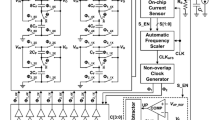Abstract
Varying a supply voltage using a DC-to-DC converter can significantly improve the efficiency of RF power amplifiers (PAs) for low-power RF transceivers. However, intrinsic switching noise from a conventional DC-to-DC converter operating in fixed Pulse-Width Modulation (PWM) can affect the system performance since the spectral components in the switching noise are confined in the fundamental switching frequency and its harmonics. This harmonic noise will have detrimental effects on the performance of the microwatt’s transmitter due to its low output power. Especially for microwatts systems, the minimized size of the inductor will increase the spurious noise due to increased peak-to-peak inductor current. By relocating the spurious noise and reducing peak noise from a switching converter, this paper proposes the technique to prevent high noise spurs in a microwatt transmitter, combining both pseudo-random frequency stepping and monotonic frequency stepping. Both modulation circuits are implemented in CMOS 0.18 µm process and incorporated to achieve the proposed DC-to-DC converter system. The measurement results indicate that the proposed PWM ramp signal modulator with random frequency modulation in a DC-to-DC converter can reduce the peak of the spurious noise-power by 22 dB. Monotonic frequency modulation with various frequency steps reduces the peak of the spurious noise-power by 18 dB.













Similar content being viewed by others
References
Chang, C.-W., Chen, Y.-J.E., & Chen, J.-H. (2011). A power-recycling technique for improving power amplifier efficiency under load mismatch. IEEE Microwave and Wireless Components Letters, 21(10), 571–573.
. Lai, C.-M, Jau, J.-K., & Li, J.-Y. (2009). High efficiency RF power amplifier using band limited dynamic supply control method. In European microwave conference, pp. 350–353.
Roberg, M., & Popovic, Z. B. (2011). Analysis of high-efficiency power amplifiers with arbitrary output harmonic terminations. IEEE Transactions on Microwave Theory and Techniques, 59(8), 2037–2048.
Gerhard, W., & Knoechel, R. H. (2006). Improvement of power amplifier efficiency by reactive Chireix combining, power back-off and differential phase adjustment. In IEEE international microwave symposium, pp. 1887–1890.
Langridge, R. A., Thornton, T., Asbeck, P. M., & Larson, L. E. (1999). A power re-use technique for improved efficiency of outphasing microwave power amplifiers. IEEE Transactions Microwave Theory and Technique, 47(8), 1467–1470.
Pedro, J. C., Garcia J. A., & Cabral, P. M. (2007). Nonlinear distortion analysis of polar transmitter. In IEEE international microwave symposium, pp. 957–960.
Kobayashi, H., & Asbeck, P. M. (2002). Active cancellation of switching noise for DC–DC converter-driven RF power amplifiers. In IEEE international microwave symposium, pp. 1647–1650.
Nagari, A., Allier, E., Amiard, F., Binet, V., & Fraisse, C. (2012). An 8 Ω 2.5 W 1%-THD 104 dB(A)-dynamic-range class-D audio amplifier with ultra-low EMI system and current sensing for speaker protection. IEEE Journal of Solid-State Circuits, 47(12), 3068–3080.
Kwak, T.-W., Lee, M.-C., Choi, B.-K., Le, H.-P., & Cho, G.-H. (2007). A 2 W CMOS hybrid switching amplitude modulator for EDGE polar transmitters. In IEEE international solid-state circuits conference, pp. 518–519.
Lee, J., Potts, J., & Spears, E. (2006). DC/DC converter-controlled power amplifier module for WCDMA applications. In IEEE radio frequency integrated circuits symposium, pp. 1–4.
Feng, L., & Chen, D. Y. (1994). Reduction of power supply EMI emission by switching frequency modulation. IEEE Transactions on Power Electronics, 9, 132–137.
Chen, J.-H., Liu, P.-J., Hung, Y. L., Yang, H.-S., & Chen, Y.-J.E. (2010). A spur-reduced multimode power-level tracking power amplifier using a frequency-hopping DC–DC converter. IEEE Transactions on Microwave Theory and Technique, 58(5), 1333–1338.
Kim, E., Cho, C.-H., Kim, W., Lee, C.-H., & Laskar, J. (2010). Spurious noise reduction by modulating switching frequency in DC-to-DC converter for RF power amplifier. InIEEE radio frequency integrated circuits symposium, pp.43–46.
Oppenheim, A. V., & Schafer, R. W. (1999). Discrete-time signal processing. New Jersey: Prentice Hall.
Jau-Horng, C., Pang-Jung, L., & Chen, Y. J. E. (2009). A spurious emission reduction technique for power amplifiers using frequency hopping DC–DC converters. In IEEE radio frequency integrated circuit symposium, pp. 145–148.
Drissi, K. E. K., Luk, P. C. L., Bin, W., & Fontaine, J. (2003). Effects of symmetric distribution laws on spectral power density in randomized PWM. IEEE Power Electronics Letters, 1, 41–43.
Bech, M. M., Blaabjerg, F., & Pederson, J. K. (2000). Random modulation techniques with fixed switching frequency for three-phase power converters. IEEE Transactions on Power Electronics, 15(4), 753–761.
Lai, Y.-S., & Chen, S.-Y. (2012). Two-dimensional random PWM technique for full-bridge DC/DC converter. In IEEE industrial electronics society conference, pp. 846–851.
Tao, C., & Fayed, A. (2011). Spurious-noise-free buck regulator for direct powering of analog/RF loads using PWM control with random frequency hopping and random phase chopping. In IEEE international solid-state circuits conference, pp. 396–398.
Dunlap, S., & Fiez, T. (2004). A noise-shaped switching power supply using a delta–sigma modulator. IEEE Transactions of Circuits and Systems I, 51(6), 1051–1061.
Kitchen, J. N., Deligoz, I., Kiaei, S., & Bakkaloglu, B. (2007). Polar SiGe class E and F amplifiers using switch-mode supply modulation. IEEE TMTT, 55(5), 845–856.
Chen, J.-H., Liu, P.-J., & Chen, Y.-J. E. (2009). A spurious emission reduction technique for power amplifiers using frequency hopping DC–DC converters. In IEEE RFIC symposium, pp. 145–148.
Author information
Authors and Affiliations
Corresponding author
Additional information
Publisher's Note
Springer Nature remains neutral with regard to jurisdictional claims in published maps and institutional affiliations.
Rights and permissions
About this article
Cite this article
Kim, E.J., Kim, H., Cho, CH. et al. A switching frequency modulated DC-to-DC converter with reduced spurious noise for a RF power amplifier in microwatts transmitters. Analog Integr Circ Sig Process 107, 263–272 (2021). https://doi.org/10.1007/s10470-020-01736-4
Received:
Revised:
Accepted:
Published:
Issue Date:
DOI: https://doi.org/10.1007/s10470-020-01736-4




